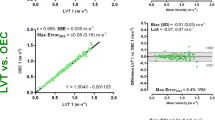Abstract
Velocity-based training (VBT) is a scientifically grounded approach to resistance training that provides trainers with precise and reliable guidance by measuring the velocity of the barbell during exercise. Inertial measurement units (IMUs) possess advantages such as low cost and compact size. However, the use of IMUs to accurately estimate velocities and displacements requires refinement due to potential measurement errors. In this paper, we introduce an innovative IMU-based method for acquiring barbell velocity and displacement and conducting motion counting. This approach combines integration and high-pass filtering, allowing for the accurate acquisition of barbell mean concentric velocity (MV), peak concentric velocity (PV), and displacement for both back squat and bench press exercises. Furthermore, it enables precise motion counting. Five healthy male participants were enlisted for the test. The results demonstrated strong correlations between our method and the linear position transmitter (LPT). For back squat and bench press exercises, the Pearson’s product moment correlation coefficient (Pearson’s r) for MV was 0.93 and 0.91, the intra-class correlation (ICC) was 0.93 and 0.91, and the coefficient of variation (CV) was 13.29% and 16.22%, respectively. For PV, the Pearson’s r was 0.92 and 0.95, the ICC was 0.92 and 0.94, and the CV was 13.46% and 17.34%, respectively. These results further demonstrated the validity and reliability of the method proposed in this paper regarding resistance training guidance.






Similar content being viewed by others
Data Availability
The data used to support the findings of this study are available from the corresponding author upon request.
6 References
Guerriero A, Varalda C, Piacentini MF (2018) The role of velocity based training in the strength periodization for modern athletes. J Funct Morphology Kinesiol 3(4). https://doi.org/10.3390/jfmk3040055
Weakley J, Mann B, Banyard H, Mclaren S, Scott T, Garcia-Ramos A (2021) Velocity-based training: from theory to application. Strength Cond J 43(2):31–49. https://doi.org/10.1519/SSC.0000000000000560
Clemente FM, Akyildiz Z, Pino-Ortega J, Rico-González M (2021) Validity and reliability of the inertial measurement unit for barbell velocity assessments: a systematic review. Sens (Basel) 21(7):2511. https://doi.org/10.3390/s21072511
García-Ramos A, Pestaña-Melero FL, Pérez-Castilla A, Rojas FJ, Gregory Haff G (2018) Mean velocity vs. mean propulsive velocity vs. peak velocity: which variable determines bench press relative load with higher reliability? J Strength Cond Res 32(5):1273–1279. https://doi.org/10.1519/JSC.0000000000001998
Ruf L, Chery C, Taylor KL (2018) Validity and reliability of the load-velocity relationship to predict the one-repetition maximum in deadlift. J Strength Cond Res 32(3):681–689. https://doi.org/10.1519/JSC.0000000000002369
Banyard HG, Nosaka K, Haff GG (2017) Reliability and validity of the load-velocity relationship to predict the 1RM back squat. J Strength Cond Res 31(7):1897–1904. https://doi.org/10.1519/JSC.0000000000001657
González-Badillo JJ, Yañez-García JM, Mora-Custodio R, Rodríguez-Rosell D (2017) Velocity loss as a variable for monitoring resistance exercise. Int J Sports Med 38(03):217–225. https://doi.org/10.1055/s-0042-120324
Sánchez-Medina L, González-Badillo JJ (2011) Velocity loss as an indicator of neuromuscular fatigue during resistance training. Med Sci Sports Exerc 43(9):1725–1734. https://doi.org/10.1249/MSS.0b013e318213f880
Harris NK, Cronin J, Taylor K, Boris J, Sheppard J (2010) Understanding position transducer technology for strength and conditioning practitioners. Strength Cond J 32(4):66–79. https://doi.org/10.1519/SSC.0b013e3181eb341b
Garnacho-Castaño MV, López-Lastra S, Maté-Muñoz JL (2015) Reliability and validity assessment of a linear position transducer. J Sports Sci Med 14(1):128–136
Lorenzetti S, Lamparter T, Luthy F (2017) Validity and reliability of simple measurement device to assess the velocity of the barbell during squats. BMC Res Notes 10(1):707. https://doi.org/10.1186/s13104-017-3012-z
Perez-Castilla A, Piepoli A, Delgado-Garcia G, Garrido-Blanca G, Garcia-Ramos A (2019) Reliability and concurrent validity of seven commercially available devices for the assessment of movement velocity at different intensities during the bench press. J Strength Cond Res 33(5):1258–1265. https://doi.org/10.1519/JSC.0000000000003118
Guerra-Filhol GB (2005) Optical motion capture: theory and implementation. RITA 12(2):61–90
Banyard HG, Nosaka K, Sato K, Haff GG (2017) Validity of various methods for determining velocity, force, and power in the back squat. Int J Sports Physiol Perform 12(9):1170–1176. https://doi.org/10.1123/ijspp.2016-0627
Held S, Rappelt L, Deutsch J, Donath L (2021) Valid and reliable barbell velocity estimation using an inertial measurement unit. Int J Environ Res Public Health 18(17):9170. https://doi.org/10.3390/ijerph18179170
Yi C, Ma J, Guo H, Han J, Gao H, Jiang F, Yang C (2018) Estimating three-dimensional body orientation based on an improved complementary filter for human motion tracking. Sens (Basel) 18(11):3765. https://doi.org/10.3390/s18113765
Yi C, Rho S, Wei B, Yang C, Ding Z, Chen Z, Jiang F (2022) Detecting and correcting IMU movements during joint angle estimation. IEEE Trans Instrum Meas 71:1–14. https://doi.org/10.1109/TIM.2022.3167771
Yi C, Wei B, Ding Z, Yang C, Chen Z, Jiang F (2022) A self-aligned method of IMU-based 3-DoF lower-limb joint angle estimation. IEEE Trans Instrum Meas 71:1–10. https://doi.org/10.1109/TIM.2022.3194935
Madgwick SO (2014) AHRS algorithms and calibration solutions to facilitate new applications using low-cost MEMS. Dissertation, University of Bristol
Funding
No funding was received for conducting this study.
Author information
Authors and Affiliations
Contributions
Methodology: BCW, STZ, JFZ, JT; Hardware: JFZ, YJL, CBC; Data collection: JT, JFZ, MQF, STZ; Data analysis: STZ; Visualization: STZ; Writing - original draft: STZ; Writing - review & editing: CFY, BCW, YJL, JFZ, JT, MQF, CBC, STZ. All authors reviewed the manuscript.
Corresponding authors
Ethics declarations
Competing Interests
The authors declare no competing interests.
Ethics Approval
The study was conducted according to the guidelines of the Declaration of Helsinki, and approved by the Chinese Ethics Committee of Registration Clinical Trials (ChiECRCT20200319).
Informed Consent
Informed consent was obtained from all participants involved in the study.
Additional information
Publisher’s Note
Springer Nature remains neutral with regard to jurisdictional claims in published maps and institutional affiliations.
Electronic Supplementary Material
Below is the link to the electronic supplementary material.
Rights and permissions
Springer Nature or its licensor (e.g. a society or other partner) holds exclusive rights to this article under a publishing agreement with the author(s) or other rightsholder(s); author self-archiving of the accepted manuscript version of this article is solely governed by the terms of such publishing agreement and applicable law.
About this article
Cite this article
Zhang, S., Yang, C., Zhu, J. et al. A Method for Obtaining Barbell Velocity and Displacement and Motion Counting Based on IMU. Mobile Netw Appl (2024). https://doi.org/10.1007/s11036-024-02293-0
Accepted:
Published:
DOI: https://doi.org/10.1007/s11036-024-02293-0




